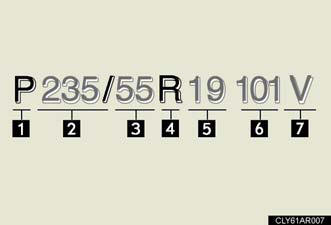Tire information
Typical tire symbols
- Standard tire.

- Compact spare tire.

1. Tire size .
2. DOT and Tire Identification Number (TIN).
3. Location of treadwear indicators.
4. Tire ply composition and materials.
Plies are layers of rubber-coated parallel cords. Cords are the strands which form the plies in a tire.
5. Radial tires or bias-ply tires.
A radial tire has “RADIAL” on the sidewall. A tire not marked “RADIAL” is a bias-ply tire.
6. TUBELESS or TUBE TYPE.
A tubeless tire does not have a tube and air is directly put into the tire. A tube type tire has a tube inside the tire and the tube maintains the air pressure.
7. Load limit at maximum cold tire inflation pressure.
8. Maximum cold tire inflation pressure.
This means the pressure to which a tire may be inflated.
9. Uniform tire quality grading.
For details, see “Uniform tire quality grading” that follows.
10. Summer tire or all season tire.
An all season tire has “M+S” on the sidewall. A tire not marked “M+S” is a summer tire.
11. “TEMPORARY USE ONLY”.
A compact spare tire is identified by the phrase “TEMPORARY USE ONLY” molded on its sidewall. This tire is designed for temporary emergency use only.
Typical DOT and tire identification number (TIN)

1. DOT symbol*
2. Tire Identification Number (TIN)
3. Tire manufacturer's identification
mark
4. Tire size code
5. Manufacturer's optional tire
type code (3 or 4 letters).
6. Manufacturing week.
7. Manufacturing year.
*: The DOT symbol certifies that the tire conforms to applicable Federal Motor Vehicle Safety Standards.
Tire size
Typical tire size information

The illustration indicates typical tire size.
1. Tire use
(P = Passenger car,
T = Temporary use).
2. Section width (millimeters).
3. Aspect ratio
(tire height to section width).
4. Tire construction code (R = Radial, D = Diagonal).
5. Wheel diameter (inches).
6. Load index (2 digits or 3 digits).
7. Speed symbol
(alphabet with one letter).
Tire dimensions

1. Section width.
2. Tire height.
3. Wheel diameter.
Tire section names

1. Bead.
2. Sidewall.
3. Shoulder.
4. Tread.
5. Belt.
6. Inner liner.
7. Reinforcing rubber.
8. Carcass.
9. Rim lines.
10. Bead wires.
11. Chafer.
Uniform Tire Quality Grading
This information has been prepared in accordance with regulations issued by the National Highway Traffic Safety Administration of the U.S.
Department of Transportation.
It provides the purchasers and/or prospective purchasers of Lexus vehicles with information on uniform tire quality grading.
Your Lexus dealer will help answer any questions you may have as you read this information.
DOT quality grades
All passenger vehicle tires must conform to Federal Safety Requirements in addition to these grades. Quality grades can be found where applicable on the tire sidewall between the tread shoulder and maximum section width.
For example: Treadwear 200 Traction AA Temperature A
Treadwear
The treadwear grade is a comparative rating based on the wear rate of the tire when tested under controlled conditions on a specified government test course.
For example, a tire graded 150 would wear one and a half (1 - 1/2) times as well on the government course as a tire graded 100.
The relative performance of tires depends upon the actual conditions of their use, however, and may depart significantly from the norm due to variations in driving habits, service practices and differences in road characteristics and climate.
Traction AA, A, B, C
The traction grades, from highest to lowest, are AA, A, B and C, and they represent the tire's ability to stop on wet pavement as measured under controlled conditions on specified government test surfaces of asphalt and concrete.
A tire marked C may have poor traction performance.
Warning: The traction grade assigned to this tire is based on braking (straight ahead) traction tests and does not include cornering (turning) traction.
Temperature A, B, C
The temperature grades are A (the highest), B, and C, representing the tire's resistance to the generation of heat and its ability to dissipate heat when tested under controlled conditions on a specified indoor laboratory test wheel.
Sustained high temperature can cause the material of the tire to degenerate and reduce tire life, and excessive temperature can lead to sudden tire failure.
The grade C corresponds to a level of performance which all passenger car tires must meet under the Federal Motor Vehicle Safety Standard No. 109.
Grades B and A represent higher levels of performance on the laboratory test wheel than the minimum required by law.
Warning: The temperature grades for this tire are established for a tire that is properly inflated and not overloaded.
Excessive speed, underinflation, or excessive loading, either separately or in combination, can cause heat buildup and possible tire failure.
Glossary of tire terminology






*:Table 1 Occupant loading and distribution for vehicle normal load for various designated seating capacities

See also:
Items to initialize
The following items must be initialized for normal system operation in
cases
such as after the 12-volt battery is reconnected, or maintenance is performed
on the vehicle.
...
Driving It
Driving Impressions
Comfortable, controllable and quick with either powertrain or drivetrain
combination, the 2011 Lexus GS is an excellent all-around performer that should
please all but the mo ...
If the electronic key does not operate properly
If communication between the electronic key and vehicle is interrupted
or the electronic key cannot be used because the battery is
depleted, the smart access system with push-button start and wirele ...
